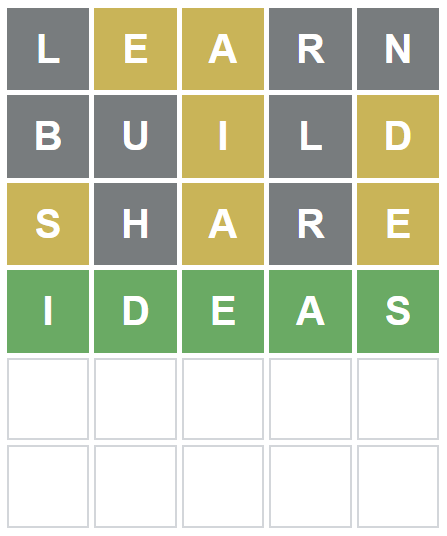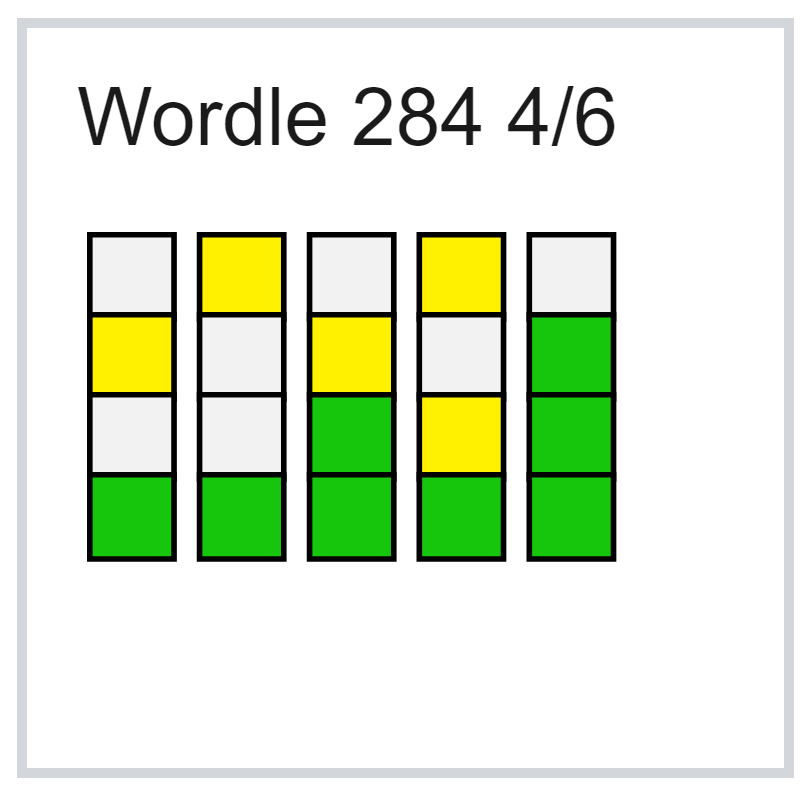
We’re Enchant. Companies of all shapes and sizes use Enchant to level up their customer experiences. We love interesting business models, and we think Wordle’s ridiculously viral model is brilliant.
If you’ve spotted grids of green and yellow squares all over your social media in the last few months, you’ve seen Wordle. Maybe you’re even hooked on playing already. From humble beginnings, the deceptively simple game has been bought by the New York Times for an undisclosed amount “in the low seven figures”.
What is Wordle?

Wordle is a word guessing game made by Josh Wardle as a gift for his partner, Palak Shah.
“I wanted to try making a game that she and I would enjoy playing together, and Wordle was a result of that.” - Josh Wardle.
Every day players get six guesses to figure out the five letter word. Players start with a blank grid. With each guess, letters change color. Letters not in the word turn gray. Letters in the word, but in the wrong spot turn yellow. And letters in the right place turn green.
You can share (or hopefully brag about) your results by posting your colored grid on social media. Everyone is in on it, including some of the world’s biggest brands.
Wordle’s story is packed full of lessons you can apply to your business. Let’s take a look.
1. Keep It Simple Yet Interesting
One word. Six guesses. Easy, right? It’s engaging fun for players of all ages.
But simple doesn’t mean easy. With everyone in the world getting the same word, Wordle players around the globe are united as they sweat over the answer.
The simplicity of the gameplay gets players hooked quickly. If you win, you want to play again the next day to repeat your success. If you don’t, you want to play again the next day to see if you can best Wordle this time.
The lesson for your business: Keep things easy. Wordle doesn’t require sign up or payment. Now of course, that may not work for a more complex app but a no commitment trial can be a big plus. It’s also in your best interest to make sign up as easy as possible. Only ask for the info you need, and don’t overwhelm your new clients with information. When it comes to the product keep the interface intuitive and user friendly.
2. Leave Them Wanting More
Let’s be real, games can be a real time waster! You think “I’ll just play for five minutes” and the next thing you know, you’ve spent an hour farming crops or fighting zombies.
Wordle is different. You can only play once a day, so players don’t feel like they’re wasting their time or getting addicted.
You couldn’t binge play Wordle even if you wanted to, which creates a delicious sense of scarcity. No matter how much you love Wordle, once you’ve done the day’s puzzle, you have to wait till the next day.
A bit like waiting for Christmas as a kid!
Some people start the new Wordle as soon as it drops. Some people have made it part of their morning routine. This was a smart decision on the developer’s part, because it builds anticipation every day.

Releasing a puzzle each day creates immediacy. People can’t come back tomorrow if they’re too busy. Each puzzle is a one-time event, and that makes people want to show up.
The lesson for your business: Keep your clients engaged. Notify them of new products that fit their interests, give regular updates, or send tips and tricks they might not know yet. Design your product in such a way that new features, including paid ones, are easy to discover and try out.
3. Bring Value To A Single Person
Wordle hits the sweet spot of bringing people together, while still being fun to play alone. Unlike some online games such as Words With Friends, you don’t need other people to play together at the same time.
It’s easy to pick Wordle up and play for a few minutes during morning coffee or on your commute. This simplicity gives Wordle a comforting, easy vibe that makes it even more likable.
Wordle gives great value in a short space of time. And there are no ads, no pleas to rate the app, and no in-game purchases . The app is literally there to have fun with. Nothing more.
I think people have an appetite for things that transparently don’t want anything from you.
The lesson for your business: Value, value, value. Focus on giving excellent value to your customers and leave them feeling that they love your business and want to stay loyal. Delight them with well thought out features, reasonable pricing tiers, and awesome customer service, designed with their needs in mind.
4. Give People The Opportunity To Connect
Whether you challenge your friends to see who can solve it fastest, or go on Twitter to see what people are saying about the daily puzzle, Wordle brings people together.
The New York Times started a thread about the benefits of guessing vowel heavy words. Some people went all-in on it, while others were consonant-first people. Chewing over the best strategies with others creates community.
There’s a touch of healthy competition too. Of course you want to be the one in your circle to turn that grid green!
The lesson for your business: Create a community for your clients to share their ideas. A Facebook group, speaking at events relevant to your customers’ industry or demographic, or even a weekly newsletter, all create community. Start a hashtag or even a challenge for people to follow along with. Get them talking about your business, among each other.
5. Learn From How The Pros Are Using Your Product
One of the things people love about Wordle is the shareable grids. At first people were posting on social media or group chats saying “Wordle in three.”
Then a player in New Zealand, known as Elizabeth S, created the now famous green, gray and yellow emoji grid to show her results without spoilers.

Wordle grids create intrigue and interest on your social network, and get others to check it out. Shares don’t include a link to Wordle, which creates even more curiosity.
“I saw other people start doing it and then manually typing out the emoji grid. So I’m like, I can make this, I can just pull this into the game. And obviously that’s had a huge impact in helping it go viral.” - Josh Wardle
Noticing how much players liked the grids helped Wordle spread like wildfire. On Nov 1, there were 90 players. By the end of December, there were 300,000. Josh announced the share feature on 16 December 2021, and in January the number of players had grown beyond 10 million.
The lesson for your business: Find out how people are using your product. Talk to your pro users, and look at metrics to see what’s getting the most traction, and what isn’t. Your customers can give you insights into what people love about your business. Customer feedback helps you create better customer experiences which leads to higher customer satisfaction ratings.
6. Make It Easy To Get
Wordle has always been easily accessible. Anyone can play for free through their browser. It’s not limited to a certain app store, and you don’t have to sign up for an account.
The timing of Wordle contributed to its success, too.
Wordle arrived at a time when everyone needed a win. The old things that brought us pleasure: shopping, eating in restaurants, attending school events, are now fraught with worry.
Wordle gave us a new, safe, way to stay connected with loved ones, and a much-needed mental break during isolation. It was a simple no-risk way to accomplish something.
The lesson for your business: Make your products, store, or website, easy to access and mobile friendly. If you have an online store, give your customers a convenient way to search for the products they want. If you offer software or apps, make it easy for customers to find answers in your knowledge base. No matter what kind of business you have, ensure your customers can reach out to customer support from any device and get answers to their problems. Make sure customers can get what they need with no hassle.
Why The New York Times Bought Wordle For $1 Million
In 2020, the most searched terms on the New York Times website weren’t “Trump” or “Biden”. Not even “coronavirus” topped the list.
The most searched terms were “crosswords” and “spelling bee.”.
Looking to gain more subscribers in the wake of the election, NYT capitalized on this hunt for word games by hiring Jonathan Knight, who helped popularize FarmVille and Words With Friends. Knight says that games are like dessert at the end of the meal, and a “healthy diversion from the news.”
Games are a healthy diversion from the news.
NYT was already seeing good engagement from its gaming subscription product, with games like Spelling Bee. When Wordle became a casual gaming sensation, NYT knew it would fit perfectly with their games platform.
Capturing the latest viral gaming sensation means New York Times stays relevant and can grow its subscriber base.
What’s the future of Wordle? Well, we don’t have a crystal ball so we can’t say for sure. The internet reckons that going by the size of its word bank, Wordle will run out of words in around seven years. Some people wonder if it might become a paid product down the road.
One thing’s for sure. Wordle was created and maintained ad free just for pure enjoyment. That’s a legacy that will live on.
Wordle’s simplicity teaches us that we don’t always have to reinvent the wheel. Sometimes we just need to keep doing what’s working, or making small tweaks to be more in line with customer needs. The key is to pay attention to what people want, and deliver that with honesty and authenticity.
Need something to tide you over until the next Wordle drops? Check out these Wordle alternatives:
Word Master looks and feels just like Wordle, with the addition of a “play again” button so you can try a new puzzle as soon as you solve the current one.
If Wordle isn’t challenging enough, try Quordle! You’ll be guessing four words at once, and with only three additional guesses compared to Wordle.
Adverswordle is like Wordle, but backwards. You pick the word and the AI tries to guess it. The aim is to make it guess as many times as possible.